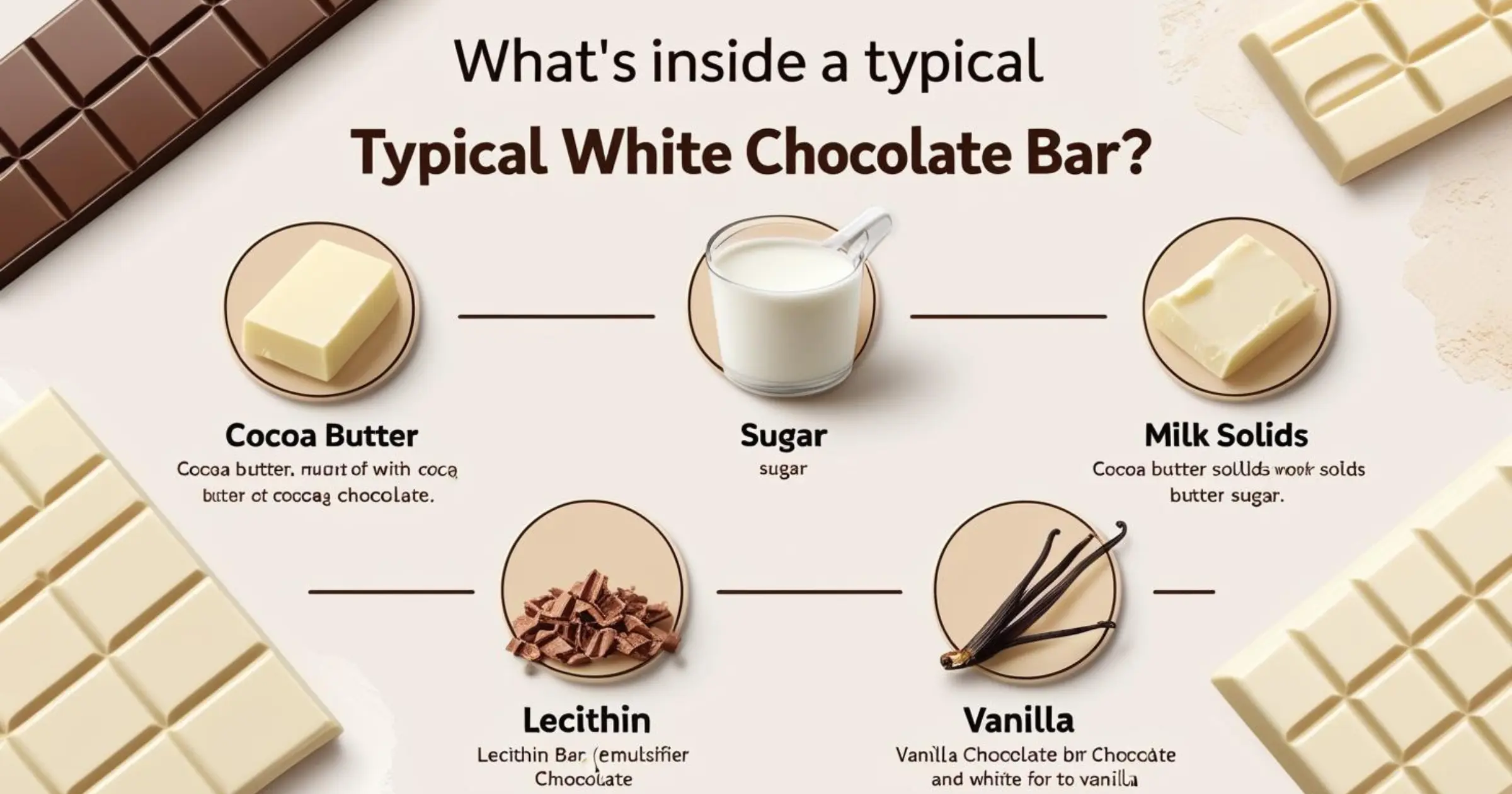🧾 What’s Inside a Typical White Chocolate Bar? Unwrapping the Sweet Secrets
✨ There’s Something Magical About White Chocolate…
The first time you tasted white chocolate, you probably noticed how different it was—creamy, sweet, and comforting without the intense bitterness of dark chocolate. Maybe it came in a festive holiday box or as a decorative swirl on your favorite dessert.
But here’s the thing: Have you ever really thought about what’s inside a white chocolate bar?
Today, we’re unwrapping all the sweet secrets. From the key ingredients to how it’s made, its nutritional value, and even how you can make one at home—we’re diving deep into this silky-smooth confection.
Table of Contents
🍫 What Exactly Is White Chocolate?
White chocolate is a bit of a sweet mystery. Some call it “not real chocolate,” but legally and technically, it does meet the criteria—as long as it contains a minimum of 20% cocoa butter and 14% milk solids, according to the FDA.
White Chocolate vs. Other Types:
- No cocoa solids (the part that gives dark chocolate its color and bitterness)
- Made mostly from cocoa butter, milk powder, and sugar
- Much sweeter and creamier in taste
In short: it’s not fake, but it is different. And that’s exactly why people either love it—or pass on it.
🥛 Main Ingredients in a White Chocolate Bar
So what’s really inside that glossy white square?
H3: Core Ingredients
- Cocoa Butter – extracted from cocoa beans, it gives that rich, melt-in-mouth feel.
- Milk Solids or Milk Powder – adds creamy texture and a dairy-like flavor.
- Sugar – often the largest ingredient by weight.
- Lecithin – an emulsifier to keep everything smooth.
- Vanilla or Vanillin – for extra aroma and sweetness.
🧾 Ingredient Table
| Ingredient | Function in Chocolate | Common Source |
|---|---|---|
| Cocoa Butter | Smooth texture, base fat | Cocoa beans |
| Milk Solids | Creaminess, flavor | Dairy (cow’s milk) |
| Sugar | Sweetness | Cane or beet sugar |
| Lecithin | Emulsifier | Soy or sunflower seeds |
| Vanilla/Vanillin | Flavor enhancer | Natural or synthetic |
🔍 Nutritional Value of White Chocolate Bar
White chocolate might be delicious—but it’s also rich, both in taste and calories.
Nutritional Highlights (per 100g):
- Calories: ~540 kcal
- Fat: 30g (19g saturated)
- Sugar: ~50g
- Protein: ~6g
- Fiber: <1g
- Caffeine: 0 mg
Compared to dark chocolate, white chocolate has no antioxidants (like flavonoids), no caffeine, and a much higher sugar content.
🏭 How Are White Chocolate Bars Made?
Making white chocolate isn’t as simple as just melting cocoa butter and sugar. Here’s how it’s done professionally:
H3: Step-by-Step Process
- Extract Cocoa Butter from fermented, roasted cocoa beans
- Mix with Milk Powder and Sugar
- Add Lecithin and Vanilla
- Conching – an intensive mixing process for smoothness
- Tempering and Molding – gives that snap and glossy finish
- Packaging – often foil-wrapped to protect cocoa butter
🍴 How to Make Homemade White Chocolate Bars
Want to try crafting your own? Here’s a simple recipe for a basic white chocolate bar.
🧾 Ingredients Table
| Ingredient | Quantity |
|---|---|
| Cocoa Butter | 100g |
| Powdered Sugar | 50g |
| Whole Milk Powder | 30g |
| Vanilla Extract | 1 tsp |
| Lecithin (optional) | 1 tsp |
Instructions:
- Melt cocoa butter using a double boiler.
- Slowly whisk in sugar and milk powder.
- Add vanilla and lecithin (if using).
- Pour into chocolate molds, tap to release air bubbles.
- Cool at room temperature or refrigerate for 1–2 hours.
🤔 Is White Chocolate Healthy?
Let’s be honest—it’s not a health food, but it’s not toxic either.
Pros:
- Contains calcium from milk solids
- No caffeine – great for sensitive individuals
- Provides energy (high-calorie content)
Cons:
- High in sugar
- High in saturated fats
- Low in nutrients compared to dark chocolate
Enjoy in moderation, especially if you’re watching your sugar or fat intake.
🆚 White Chocolate vs. Milk and Dark Chocolate
⚖️ Comparison Table
| Feature | White Chocolate | Milk Chocolate | Dark Chocolate |
|---|---|---|---|
| Cocoa Solids | ❌ None | ✅ Yes | ✅ High |
| Cocoa Butter | ✅ High | ✅ Moderate | ✅ Moderate |
| Sugar Content | 🔼 Highest | Medium | 🔽 Lowest |
| Antioxidants | ❌ None | ✅ Moderate | ✅ High |
| Caffeine | ❌ None | ✅ Some | ✅ High |
💡 Fun Facts About White Chocolate Bars
- Invented in Switzerland by Nestlé in the 1930s
- Often used as a base for flavored bars (matcha, strawberry, lemon)
- In Japan, white chocolate KitKats are bestsellers
- Used in desserts for decoration due to its bright color
- Melts faster than dark chocolate (lower melting point)
❓ FAQ About White Chocolate Bars
Is white chocolate real chocolate?
Technically, yes. It’s made from the cocoa bean (via cocoa butter), but it lacks the solids found in dark and milk chocolate.
Why is white chocolate sweeter?
It doesn’t have any bitter cocoa solids, so manufacturers often use more sugar to balance the milk powder and fat.
Can white chocolate go bad?
Yes. It can develop a chalky appearance known as fat bloom, especially in warm or humid environments.
Are there vegan white chocolate bars?
Absolutely! They’re made using coconut milk powder, cashew milk, or oat milk, along with plant-based sweeteners and cocoa butter.
🏁 Conclusion: Unwrapping the Truth Behind Every Bite
The next time you unwrap a creamy white chocolate bar, you’ll know exactly what’s inside. From cocoa butter and milk solids to a generous helping of sugar and vanilla, white chocolate is a dessert that’s as rich in flavor as it is in history.
Whether you’re enjoying a commercial bar or crafting your own homemade version, there’s no denying that white chocolate has earned its place in the world of sweets—one melt-in-your-mouth bite at a time.

